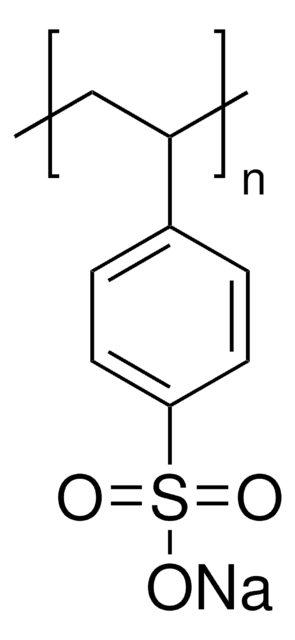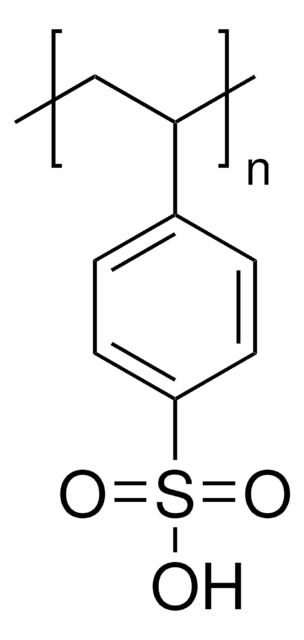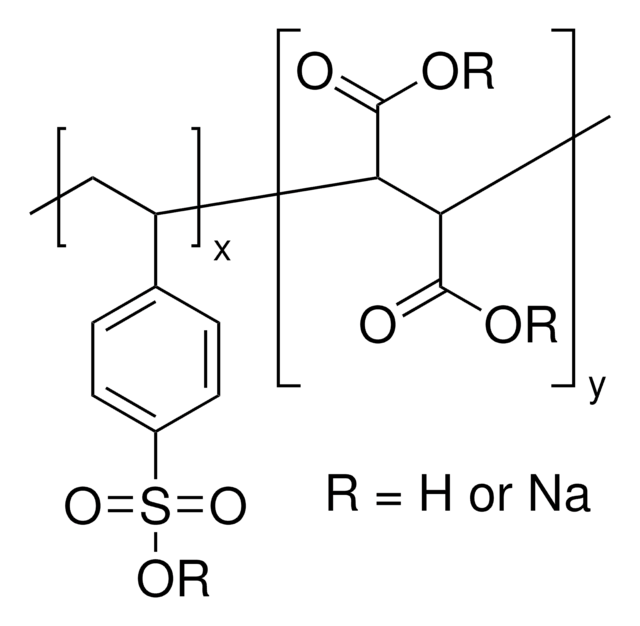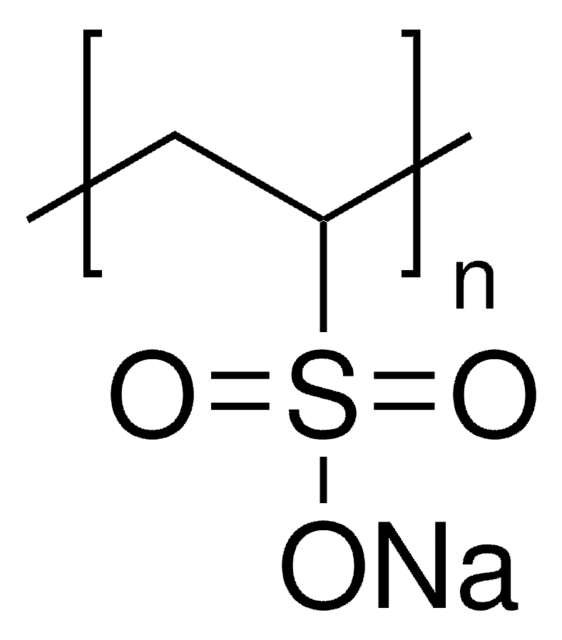561967
Poly(sodium 4-styrenesulfonate) solution
average Mw ~200,000, 30 wt. % in H2O
Synonyme(s) :
PSS, Poly(4-styrenesulfonic acid) sodium salt
About This Item
Produits recommandés
Poids mol.
average Mw ~200,000
Niveau de qualité
Concentration
30 wt. % in H2O
Indice de réfraction
n20/D ~1.3961
pH
~6.4
Viscosité
~118 cP
Densité
1.1471 g/mL at 25 °C
Chaîne SMILES
[S](=O)(=O)(O)c1ccc(cc1)C=C
InChI
1S/C8H8O3S/c1-2-7-3-5-8(6-4-7)12(9,10)11/h2-6H,1H2,(H,9,10,11)
Clé InChI
MAGFQRLKWCCTQJ-UHFFFAOYSA-N
Vous recherchez des produits similaires ? Visite Guide de comparaison des produits
Catégories apparentées
Description générale
Application
- Stabilization of low-cost phase change materials for thermal energy storage applications: This study explores the potential of Poly(sodium 4-styrenesulfonate) in stabilizing low-cost phase change materials, enhancing thermal energy storage capabilities (DO Akamo et al., 2023).
- UPCONVERTING NANOPARTICLES FOR BIOSENSING AND BIOIMAGING: Research on Poly(sodium 4-styrenesulfonate) utilized in biosensing and bioimaging via upconverting nanoparticles, highlighting its applications in high-temperature bioanalytical settings (V ANDRIGO, 2023).
- Chain Dynamics in a Polyelectrolyte Solution Under Shear: A Rheological NMR Investigation: Examines the chain dynamics of Poly(sodium 4-styrenesulfonate) under shear, providing insights into its rheological behavior (S Bartosch et al., 2023).
- Molecular conformation of polyelectrolytes inside Layer-by-Layer assembled films: This research delves into the structural properties of Poly(sodium 4-styrenesulfonate) within multilayered assemblies, contributing to materials science (P Gutfreund et al., 2023).
- Colloidal nanomedicines with prolonged release of chloroquine based on interactions with aromatic polymers after mixing two liquids: from in silico simulation of : Discusses the development of colloidal nanomedicines using Poly(sodium 4-styrenesulfonate), showcasing prolonged drug release capabilities (MG Villamizar-Sarmiento et al., 2024).
Caractéristiques et avantages
Code de la classe de stockage
12 - Non Combustible Liquids
Classe de danger pour l'eau (WGK)
WGK 2
Point d'éclair (°F)
Not applicable
Point d'éclair (°C)
Not applicable
Équipement de protection individuelle
Eyeshields, Gloves, multi-purpose combination respirator cartridge (US)
Faites votre choix parmi les versions les plus récentes :
Déjà en possession de ce produit ?
Retrouvez la documentation relative aux produits que vous avez récemment achetés dans la Bibliothèque de documents.
Les clients ont également consulté
Articles
We present an article that discusses two applications in particular; first, using these layers as polyelectrolyte membranes to control permeability.
Notre équipe de scientifiques dispose d'une expérience dans tous les secteurs de la recherche, notamment en sciences de la vie, science des matériaux, synthèse chimique, chromatographie, analyse et dans de nombreux autres domaines..
Contacter notre Service technique





